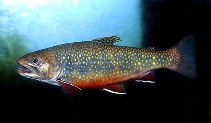| Family: |
Salmonidae (Salmonids), subfamily: Salmoninae |
| Max. size: |
86 cm SL (male/unsexed); max.weight: 8,000.0 g; max. reported age: 24 years |
| Environment: |
benthopelagic; freshwater; brackish; marine; depth range 15 - 27 m, anadromous |
| Distribution: |
North America: native to most of eastern Canada from Newfoundland and Labrador to western side of Hudson Bay; south in Atlantic, Great Lakes, and Mississippi River basins to Minnesota and northern Georgia (Applachian Mountains), USA; headwaters of Chattahoochee River (Gulf basin). Introduced widely in North America and temperate regions of other continents. Several countries report adverse ecological impact after introduction. |
| Diagnosis: |
Dorsal spines (total): 3-4; Dorsal soft rays (total): 8-14; Anal spines: 3-4; Anal soft rays: 8-14; Vertebrae: 58-62. Distinguished by the combination of dark green marbling on its back and dorsal fin and by the red spots with blue halos on its sides (Ref. 27547). Pelvic fins with axillary process; caudal nearly straight or with a shallow indentation (Ref. 27547). Color varies, but generally rather green to brownish on back, marked with paler vermiculations or marbling that extend onto the dorsal fin and sometimes the caudal; sides lighter than back, marked with numerous pale spots and some red spots, each of the latter surrounded by a blue halo; anal, pelvic and pectoral fins with a white leading edge followed by a dark stripe, the rest of the fins reddish (Ref. 27547). In spawning fish the lower sides and fins become red (Ref. 27547). Sea-run fish are dark green above with silvery sides, white bellies and very pale pink spots (Ref. 27547). Caudal fin with 19 rays (Ref. 2196). |
| Biology: |
Occurs in clear, cool, well-oxygenated creeks, small to medium rivers, and lakes (Ref. 5723, 86798). Nerito-pelagic (Ref. 58426). Anadromous in some populations (Ref. 86798). In its native range, general upstream movements have been observed in early spring, summer and late fall; downstream movements, in late spring and fall (Ref. 28546, 28548, 28549, 28550). Some fish, popularly known as salters, run to the sea in the spring as stream temperature rises, but never venture more than a few kilometers from river mouths. It may remain at sea for up to three months (Ref. 28546, 28549, 28551). Feeds on a wide range of organisms including worms, leeches, crustaceans, insects (chironomids, caddisflies, blackflies, mayflies, stoneflies and dragonflies (Ref. 5951), mollusks, fishes and amphibians (Ref. 3348, 10294); also small mammals (Ref. 1998). Stomachs of some individuals contained traces of plant remains (Ref. 1998). There are reports of introduced fish reaching 15 years of age in California, USA (Ref. 28545). Cultured for food and for stocking (Ref. 27547). Extensively used as an experimental animal (Ref. 1998). Marketed fresh and smoked; eaten fried, broiled, boiled, microwaved, and baked (Ref. 9988). |
| IUCN Red List Status: |
Not Evaluated (N.E.) Ref. (130435)
|
| Threat to humans: |
potential pest |
Source and more info: www.fishbase.org. For personal, classroom, and other internal use only. Not for publication.
